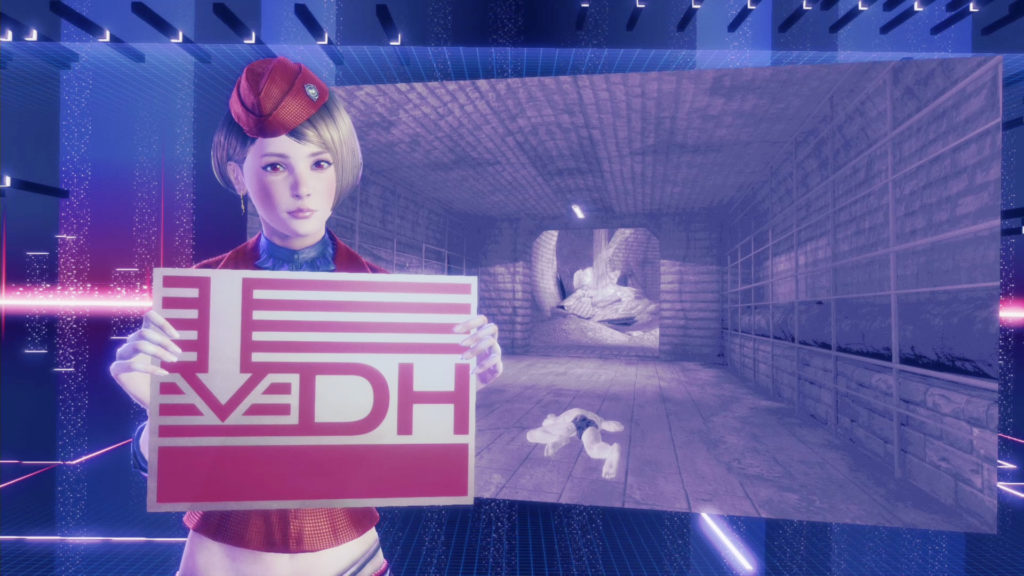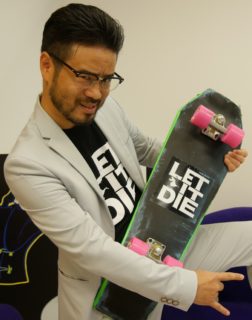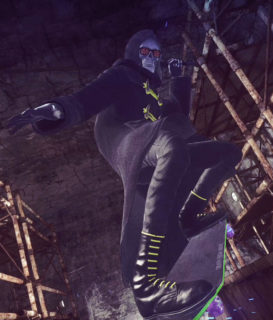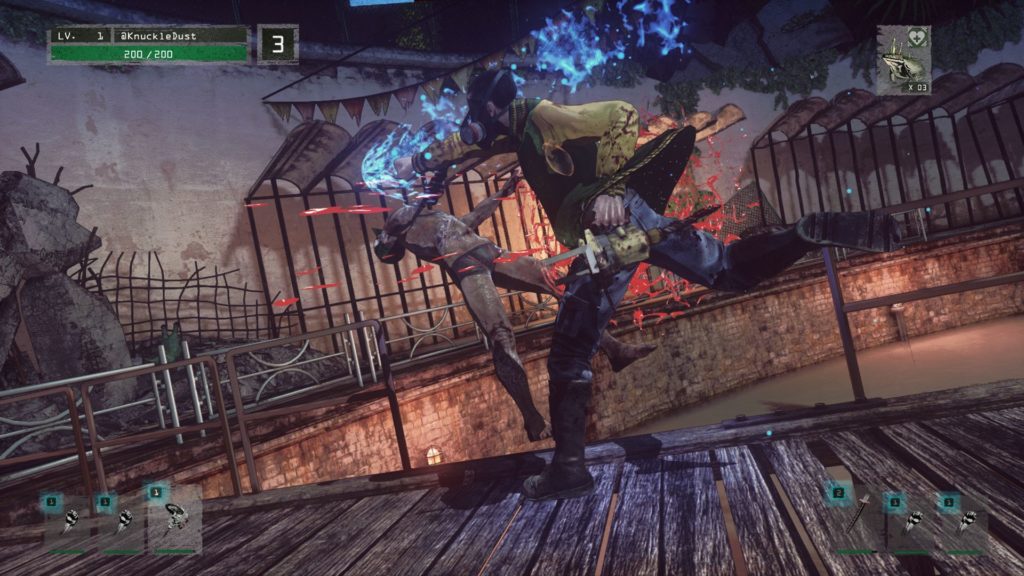Let It Die is an over-the-top, free-to-play, online hack-and-slash roguelike action game releasing exclusively for the PlayStation 4 later this year. It features a crazy post-apocalyptic Tokyo setting where players battle both monsters and each other to the death to ascend the Tower of Barbs floor-by-floor until they reach the promise of treasure at the top. Along the way, players acquire weapons and skills needed to take on bigger challenges. The catch is that if you die while making your way through the Tower, you’ll lose all the equipment you picked up since the last time you visited your home base, and you’ll have to start from the beginning with a new or alternate character.
Although the title might suggest otherwise, Let It Die is not completely about dying in fantastically gory ways. The game monetizes through “insurance” sales, which are essentially resurrection opportunities that can be purchased by players using either in-game or real currency. Additionally, dead characters are revived at the spot where they perished as computer controlled characters called Haters, which will also appear in other people’s games. Therefore, players have a chance to reclaim their fallen characters and equipment by battling these Haters. Alternatively, Haters can be left wandering the tower to take on other players in the game and earning special rewards.

There are also the zany and unique characters, which are practically a hallmark of games made by Japanese developer Grasshopper Manufacture (which also made Killer Is Dead and Lollipop Chainsaw) and its CEO, Goichi Suda (aka Suda51). One of the most prominent characters is a skateboard-riding grim reaper named Uncle Death, who wears novelty glasses and acts as a kind of guide. Ironically, Uncle Death helps bring the story to life by adding a sense of humor to a survival game that features a ton of gore and menacing creatures.

Let It Die’s director, Hideyuki Shin, recently spoke to [a]listdaily through a translator about working on its first project with Puzzle & Dragons creator, GungHo Online Entertainment, which acquired Grasshopper Manufacture in 2013.
After working with GungHo on Let It Die for three years, we asked about how it stood out from previous Grasshopper games and how GungHo was helping to develop and promote it. Shin responded by saying that the biggest difference from previous games is online and PvP (player-vs-player) elements. Grasshopper had not had any titles with online capabilities before. Furthermore, Grasshopper had only made packaged titles before working with the GungHo group.
“With this new initiative, not only has GungHo provided information and know-how for making online games, but they’ve also had GungHo members come into Grasshopper to create the game together—as opposed to saying, as a publisher, we want these things,” said Shin. “They actually came in to be very direct and hands-on with the development process, which is something completely new.”
Given Grasshopper’s history, we asked why the developer decided on a free-to-play model. Shin said that “it wasn’t necessarily the case that, during the development process, we said ‘this would be better free-to-play.’ It was decided from the very beginning, before anything was put together, that the first initiative that Grasshopper would do with GungHo was to make a free-to-play action game.”
When discussing how he kept a roguelike game, where players must start from the beginning if they die, interesting and motivating for its players, Shin explained that players don’t necessarily have to start with nothing after they perish. Several factors, including the character’s skill mastery and experience level, remain unchanged and players have a chance to go back and reclaim them. Additionally, crafted equipment is available when players restart, and they can purchase new items from the in-game shop.
 Then, of course, we asked about how Grasshopper came up with the crazy characters that often show up in its games. “We get asked that a lot,” said Shin. “It’s not necessarily, at Grasshopper, we say ‘oh, we need to make unique characters.’ Making new characters starts with Suda51 and the scenario creation with the story.” The studio starts with the world setting, then the characters come from it. “It turns into a whole creative process where everything starts influencing each other.”
Then, of course, we asked about how Grasshopper came up with the crazy characters that often show up in its games. “We get asked that a lot,” said Shin. “It’s not necessarily, at Grasshopper, we say ‘oh, we need to make unique characters.’ Making new characters starts with Suda51 and the scenario creation with the story.” The studio starts with the world setting, then the characters come from it. “It turns into a whole creative process where everything starts influencing each other.”
Let It Die features an online competitive mode where players battle each other, or they can raid another player’s base with all of his or her computer-controlled alternate characters defending it. When asked if there were any plans to include a cooperative mode, Shin said that there currently weren’t any plans to include one and that the world of Let It Die is a kill or be killed free-for-all. As for social features to connect its global players, Shin talked about the revenge list that is populated each time another player kills you, “so, you know who got you, and you can go and return the favor if you’d like to.” In the world of Let It Die, getting revenge is considered to be a kind of social event.
When asked if it was difficult to design games that are for a global audience, Shin said that “we certainly try to make games that are appealing to a global audience. A lot of times, when you think about Japanese developers, you have this image of them making games mostly for Japan and maybe the world will enjoy them. Grasshopper tries to have a more global mindset by thinking about what will appeal worldwide. It’s quite difficult because we are a Japanese studio, but we do have a lot of fun, and I think we seem to have gotten it this time.”
In discussing his thoughts about why so many players found roguelike games attractive, Shin said that “the roguelike style of games can be quite challenging and difficult, but I think people are drawn to it—not just because it’s challenging—but because there are story elements that usually follow. It drives players to continuously follow through the game to figure out what’s going on with the story. Let It Die is not entirely a roguelike because you don’t lose everything you can lose, but we do have story elements for players to enjoy. I hope that players find the pairing of the story elements with some roguelike elements to be enjoyable.”

We also asked if there was any interest in using new technology such as the PlayStation VR to help enhance or promote the game. “There are no current plans to have things like VR to add on to the experience, but I think the biggest game changer is that Let It Die is free-to-play,” said Shin. “That means anyone with a PlayStation 4 can download and play it, so we can get to a wider audience of people. With such a low barrier to entry, I think that makes it quite an interesting experience.”
Let It Die is also unique in that it features over 100 Japanese music artists, assembled by Akira Yamaoka, who is famous for making the soundtracks for horror games such as Silent Hill, Shadows of the Damned and many more. For this project, he told the bands that Grasshopper was making a game called Let It Die and asked each of them to make a song using the title as inspiration. “All of the songs in the game are titled ‘Let It Die,’” said Shin. “To get their originality, they had complete creative control, as long as it had to do with the title, Let It Die. Whatever they felt Let It Die meant is what they used their creativity to make for the game. You can unlock songs from the bands for your radio and choose the song that plays in your base. There’s also a radio station that takes the top five songs that other people are playing on their radios around the world, which can also be set to be the background music for your base.”
Finally, we asked Shin what his favorite weapon and gore finish (aka goretastic finish) move was. “My favorite goretastic finish scene is with the Magnum,” he said laughing. “If you’re able to trigger the goretastic finish move, it’s like a short scene from a movie. You bring the Magnum to their face, and they’re like, ‘No, no, no… don’t shoot me.’ Then you say ok and shoot them in the head anyway.”

